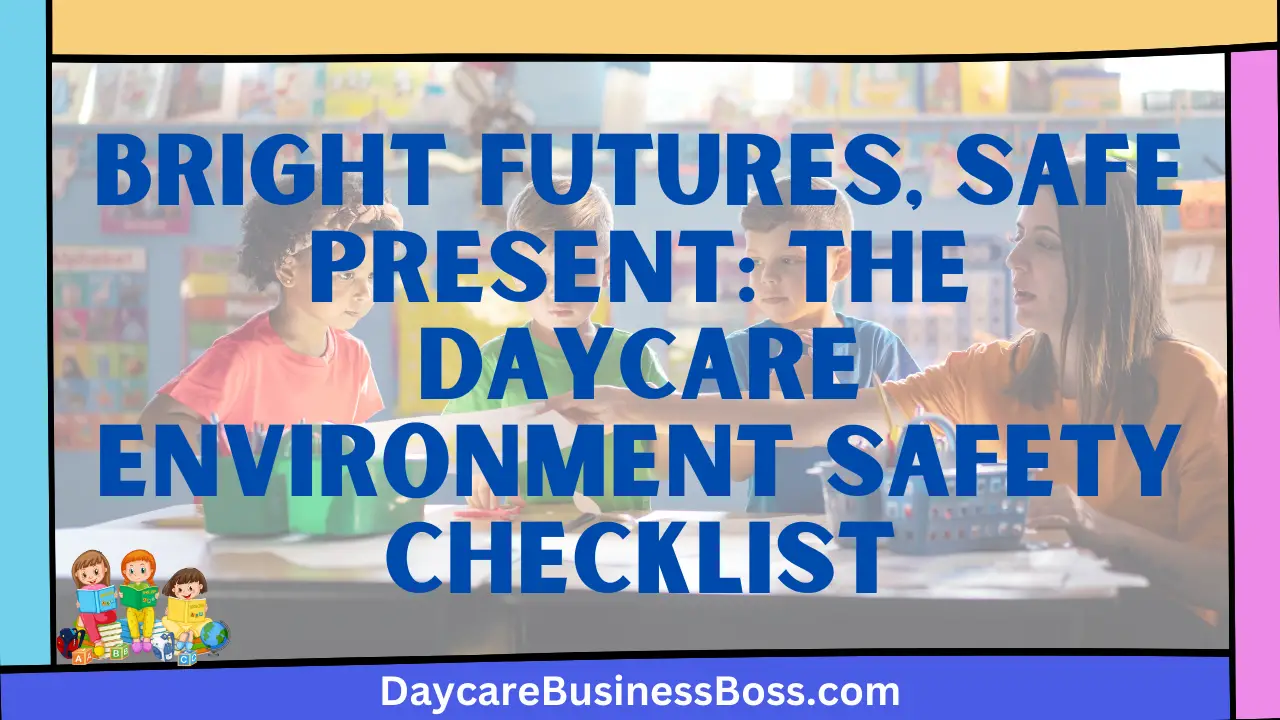In the fast-paced world of daycare, safeguarding children’s safety and well-being is critical. Daycare centers serve as a second home for many children, providing them with a place to study, grow, and socialize with their peers. Daycare providers must follow a rigorous safety checklist to ensure that this environment remains caring and secure.
The most useful daycare safety checklist includes childproofing measures (outlets, sharp corners), supervision protocols, first aid supplies, emergency plans, and sanitization routines to prevent illness.
Childproofing Measures: Outlets and Sharp Corners

Childproofing procedures are the foundation for creating a safe and protective environment in daycare centers. With their natural curiosity and limitless energy, children tend to explore their surroundings without completely grasping the possible risks that may lie nearby. As a result, installing strict childproofing standards becomes a critical step in preventing adverse situations and ensuring the well-being of the daycare’s young charges.
One of the most important aspects of childproofing is tackling common household elements that are dangerous to youngsters. Electrical outlets, for example, frequently catch the attention of small children who may insert objects into them out of curiosity. Childproof outlet covers operate as a barrier, protecting youngsters from electric shocks. These covers are simple but useful gadgets that limit access to outlets, reducing the possible danger that could result from an unintentional interaction.
The physical architecture of daycare facilities can pose dangers. Sharp furniture and fixture corners, while seemingly benign, can cause severe collisions and injuries. Childproofing is a preventative measure that involves cushioning these corners with soft materials or protective coverings. This preventative precaution dramatically decreases the effect of unintentional accidents, guaranteeing that even if youngsters accidentally bump into furniture, the chance of serious damage is greatly reduced.
Daycare centers can significantly reduce the possibility of mishaps caused by a child’s natural inquisitiveness by meticulously following these childproofing procedures. As a result, children are not only safe from potential injury, but they also have the freedom to explore and learn without continual concern.
However, childproofing is a continuous process that demands constant attention. Because of their inquisitive nature, children can adapt and discover new ways to interact with their surroundings. As a result, regular inspections and maintenance are required. Daycare workers must inspect outlets regularly to ensure that covers are firmly in place and that corner cushioning is in good shape. Daycare facilities maintain the effectiveness of their childproofing procedures by taking this diligent approach, exhibiting their unshakable dedication to the safety of every child in their care.
Read more about: Bridging Care: The Journey to Establishing a Dementia Daycare Center
Supervision Protocols: Keeping a Watchful Eye
A comprehensive supervision procedure emerges as a vital thread in the complicated tapestry of daycare safety, weaving protection, guidance, and well-being into the fabric of every child’s experience. Adequate supervision is the foundation, the attentive guardian who stands steady in the face of accidents, disagreements, and unforeseeable calamities, establishing an atmosphere in which children can develop confidence.
At the heart of this supervision routine is an unshakable dedication to safeguarding each child’s overall safety and well-being while in the care of the daycare. Trained daycare personnel are more than just observers; they are attentive sentinels, rigorously trained to keep an eye on the youngsters regardless of the activities. Children are constantly monitored, whether they are engaged in play, learning, or mundane duties, to anticipate any event that would jeopardize their safety.
Structured activities are critical components of this supervision paradigm. Careful activity planning and organization create a framework that directs a child’s energy and curiosity into focused involvement. These activities not only encourage their intellectual and creative development but also operate as a protective border, minimizing the possibility of mishaps caused by aimless wandering. The structure provides a defined path for exploration, guaranteeing that the child’s childcare experience is not only enriching but also secure.
Surprisingly, another critical aspect of this supervision equation is the child-to-staff ratio. Maintaining a low ratio gives caregivers the ability to provide personalized attention. Each child’s individuality is recognized and catered to, forming a sense of trust that lays the path for effective supervision. Caregivers are not only present when the ratio is appropriate; they are present with purpose. This proximity enables them to intervene quickly in the event of an emergency, a conflict, or an incident requiring guidance. Caregivers can quickly address problems with a reduced child-to-staff ratio, minimizing possible dangers before they worsen.
The supervision protocol functions like an elaborate dance, created with the ultimate objective of children’s safety and progress in mind. The trained and dedicated daycare staff orchestrates this dance to perfection. They observe, guide, and act as needed, their presence reassuring both children and parents that safety is a top priority.
First Aid Supplies: Prompt Response to Minor Injuries
Childhood is a realm of infinite curiosity and never-ending action. Minor injuries are an unavoidable part of a child’s journey as they explore, play, and interact with their surroundings. Recognizing this reality, it is not only wise but also necessary for daycare centers to have a well-stocked and immediately accessible first aid kit. This kit serves as the first line of protection against the bumps, scratches, and minor mishaps that occur all too frequently during children’s energetic play.
A complete first aid kit is more than simply a collection of medical materials; it is a barrier against pain and a soother for tears. It should have a variety of basics, such as bandages of various sizes to treat wounds of varying severity. Antiseptics, such as hydrogen peroxide or antiseptic wipes, are essential in preventing infections and ensuring that small injuries do not become severe health issues. Adhesive tape, gauze pads, and scissors are all essential tools for efficient wound treatment.
Having the correct supplies, however, is only part of the puzzle. Daycare employees must also be trained in basic first aid methods. These caregivers are the frontline responders, providing rapid care that might be the difference between minor injuries and more significant concerns. Daycare centers guarantee that children receive the care they require by providing staff with the knowledge and abilities to treat scrapes, bruises, and minor burns. Staff workers who have received first aid training are well-prepared to give appropriate treatments, providing comfort to both children and their families.
The effectiveness of a first aid kit is determined by its preparedness for use. Regular checkups and replenishments are required to keep the kit functional. Because daycare environments are dynamic, materials are used frequently. As a result, careful monitoring is required to ensure that the first aid kit is constantly prepared to address any unexpected circumstance that may develop. Regular checks also ensure that expired goods are replaced as soon as possible, ensuring that the supplies in the kit remain functional and safe to use.
Emergency Plans: Preparedness for Unforeseen Situations

In the rich fabric of childcare, being prepared for the unexpected is a must. As guardians of children’s safety, daycare centers must have well-thought-out emergency plans in place to deal with more catastrophic catastrophes. These plans serve as a road map for the center’s response to situations such as natural catastrophes or medical emergencies, assuring the safety of the children in its care.
When volatility threatens to disrupt the normality of daycare routines, emergency plans act as a lifeline. These plans are not hazy ideas, but rather thorough strategies outlining step-by-step methods for numerous eventualities. They cover everything from evacuations to medical reactions and parent or guardian communication protocols. These strategies reduce uncertainty and hesitancy during high-stress circumstances by giving a clear path, and ensuring that quick and effective actions are taken.
Drills and simulations are essential components of these emergency plans. Practice turns plans into action, preparing daycare workers and children for actual procedure implementation. These drills help participants become acquainted with the protocols, allowing them to respond instinctively rather than reactively. Familiarity generates confidence, lowering panic and promoting a sense of control even in difficult situations. Executing these plans in a controlled atmosphere helps to develop a calm and structured response to actual emergencies.
During a crisis, the collaboration between daycare personnel and children is critical. Involving children in emergency drills not only teaches them about safety but also teaches them the value of following instructions. The preparedness atmosphere becomes a collaborative effort, generating a sense of community and togetherness among all participants.
Collaboration extends beyond the confines of the daycare center. Connecting with local emergency services and authorities is a strategic decision that expands the crisis management skills of the center. These collaborations bring essential resources, expertise, and coordination, which can be critical in emergency management. By making these relationships, daycare centers get access to a network of support that can help ensure the safety of both children and employees.
Read more about: Beyond Swings and Slides: The Essential Daycare Playground Checklist
Sanitization Routines: Preventing the Spread of Illness
A subtle threat often hides within the vivid tapestry of childcare facilities, where laughing and learning mix – the potential transmission of infections and illnesses. Children, with their unlimited energy and natural proclivity for close contact, unknowingly serve as carriers of illnesses. Sanitization rituals emerge as hidden heroes in this dynamic setting, playing a critical role in protecting young learners from contagions.
Childcare centers, which are busy hubs of activity, must be especially attentive in their attempts to prevent the transmission of illnesses. Sanitation procedures are the first line of defense. It is critical to have a thorough cleaning routine. Toys, surfaces, and communal areas must be cleaned on a regular and meticulous basis. This proactive strategy eliminates germ breeding grounds, allowing children to explore, learn, and play without avoidable health concerns.
Hand hygiene techniques are essential for infection prevention. Handwashing should be taught and reinforced to children and staff regularly. Hand cleansing with soap and water, especially before meals and after activities, lowers the possibility of germs being transferred from one surface to another. By making this a daily process, childcare centers lay a solid basis for healthy habits in young minds.
The pursuit of hygiene, however, does not end at handwashing. Proper trash disposal is also critical. Keeping waste bins strategically positioned and regularly emptied reduces the accumulation of potentially hazardous waste. The availability of hand sanitizers in strategic locations adds an extra layer of protection, especially when soap and water are not readily available. These approaches work together to provide a more comprehensive approach to cleanliness, resulting in a safer environment for children, staff, and families.
Prioritizing sanitization in daycare centers has a significant impact. By reducing the likelihood of illness outbreaks, centers not only protect their charges’ health and well-being but also generate a sense of security among parents. An environment that prioritizes cleanliness and wellness becomes a tribute to the center’s commitment to holistic care.
Frequently Asked Questions

What is the significance of childproofing in daycare safety?
To prevent accidents and injuries among curious and active children, childproofing techniques such as concealing outlets and cushioning sharp corners are vital. These precautions considerably limit the chance of electric shocks and collisions, resulting in a safer environment for children to explore and play in.
What role do supervision protocols have in childcare safety?
Protocols for supervision ensure that children are constantly monitored and cared for by trained caregivers. These protocols prevent accidents and confrontations, and they give prompt aid if a child requires assistance. Proper supervision also allows for structured activities and interventions, establishing a safe environment in which children can learn and play while being watched.
How important are emergency plans in childcare safety?
Emergency plans are essential for being prepared for unanticipated situations such as natural catastrophes or medical issues. These plans detail evacuation methods, medical response procedures, and communication techniques with parents or guardians. Regular drills and collaborations with local emergency services improve childcare centers’ ability to effectively manage crises, assuring the safety and well-being of all children in their care.
To learn more on how to start your own daycare checkout my startup documents here.
The information provided by DaycareBusinessBoss.com (“The Site”) is for general informational purposes only. All information on the Site is provided in good faith, however, we make no representation or warranty of any kind, express or implied, regarding the accuracy, adequacy, validity, reliability, availability or completeness of any information on the Site. Under no circumstance shall we have any liability to you for any loss or damage of any kind incurred as a result of the use of the Site or Reliance on any information provided on the Site. Your use of the Site and your reliance on any information on the Site is solely at your own risk.
This blog post is for educational purposes only and does not constitute legal advice. Please consult a legal expert to address your specific needs. Terms and Conditions. (https://daycarebusinessboss.com/terms-conditions/)

Meet Shawn Chun: Entrepreneur and Childcare Business Fan.
I’m a happy individual who happens to be an entrepreneur. I have owned several types of businesses in my life from a coffee shop to an import and export business to an online review business plus a few more and now I create online daycare business resources for those interested in starting new ventures. It’s demanding work but I love it. I do it for those passionate about their business and their goals. That’s why when I meet a childcare business owner, I see myself. I know how hard the struggle is to retain clients, find good employees and keep the business growing all while trying to stay competitive.
That’s why I created Daycare Business Boss: I want to help childcare business owners like you build a thriving business that brings you endless joy and supports your ideal lifestyle.


